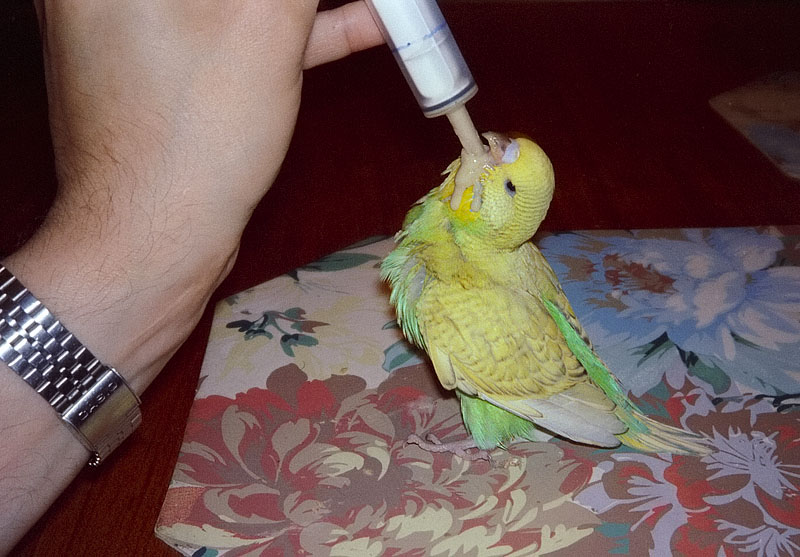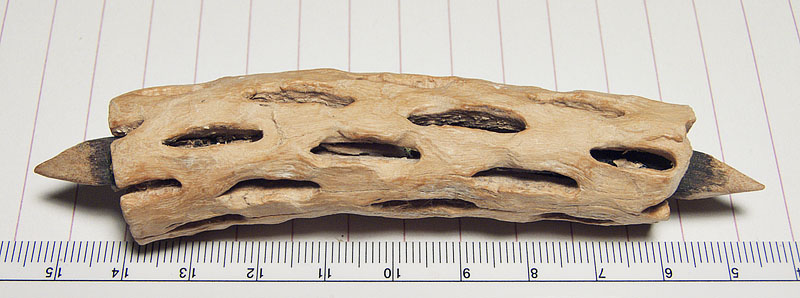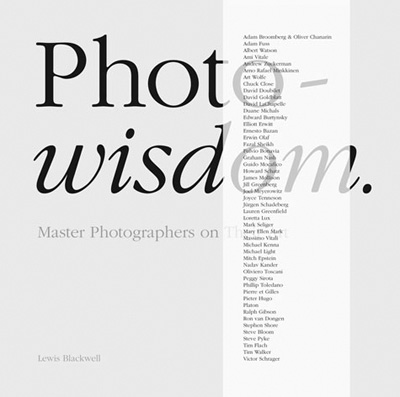 Opal as a very young bird. Wish I had a photo of him "slinky-diving."
Opal as a very young bird. Wish I had a photo of him "slinky-diving."
By Ctein
I was amused by a comment to one of my previous parrot columns that opined that parrots weren't so smart, 'cause they'd never invented anything.
'Cause, y'see, I had this tool-making budgie (a.k.a. budgerigar, a.k.a. parakeet).
I am not making this up.
It's hard for me to know if Opal was weird by budgie standards; I've never had a budgie that wasn't weird. I think weird is the budgie norm—they're little bundles of organic chaos. I raised Opal from a chick, hand feeding and weaning him (above). Growing up safe and secure made him fearless, not exactly a useful survival trait in a small prey animal, but whaddayagonnado?
Opal had a plastic slinky, both ends taped down in an upside-down U, on his play platform. He'd pluck at the loops; they'd go twang. Budgies do like making a racket. Opal started seeing how far he could yank them against the springiness; he'd stand on one side of the U and use the beak-over-claw hauling motion to pull loop after loop to one side of the U. The higher the tension, the bigger the twang when he let go.
One day he pulled as many loops as he could over, the tension nearly matching his body weight, hanging onto the topmost loop with his beak. Then he stepped onto the loops. Wham! The slinky sprung back over, whipping Opal over the top and flinging him onto his back on the other side. Opal flailed, flapped, and emitted that shrieky chitter that's the budgie's "I'm in danger" panic cry.
Then he jumped up, ran around to the other end of the slinky and did it all again. Pull, pull, step, twang, fling, SHRIEK. Over and over. He liked scaring himself.
But that's not the point of this column.
Parrots have trouble scratching around their eyes and their earholes with their claws, so they like using sharp protuberances as scratching posts. They're also Nature's own wood-chippers. Shredding stuff is a major time-sink for them. We regularly replenished Opal's supply of chew sticks; a block of wood would rarely last more than a week or two before it was sawdust.
We had a hamster chew-dowel (square cross-section stick about 6 centimeters long and half a centimeter cross) stuck into a block of cactus wood that was bolted to the top cage play area so the stick stuck out at beak level, for more chewing pleasure. Opal had gotten it down to a pointy stump maybe 1.5 cm long, well on its way to total demolition. I hypothesize that an itch struck, and he started rubbing his ear against the stump. I didn't see. Apparently a little grain-of-wheat lightbulb went off over that lentil-sized brain. Opal stopped demolishing the stump. He started trimming it. He evened up the sides, smoothed off corners and turned it into a nearly symmetric pencil-point of wood. This became his regular scratching stick and for the rest of his life (several more years), he never chewed away at that stick, save that he'd periodically slightly resharpen and reshape the tip when wear made it deviate from the desired form. He was still a mighty little sawdust machine when it came to other woody accessories. This one was special.
That's still not the point of the column. This is:
After a few months of observing this, Paula and I, being scientists by nature instead of normal people (to understand this difference see here), wondered if this might be subject to experiment. I decided to see if it was replicable. I stuck a fresh hamster dowel in the other end of the cactus wood. The feathered chain saw sprang into action, demolishing it with vigor. In a matter of days, all but a centimeter or so of that dowel was gone. The destruction stopped and finishing immediately began, much more promptly than before. With no hesitation at all Opal smoothed the sides, rounded off edges, and finished the point. When the second stick nearly matched the first, he stopped reworking it. He'd use one stick for scratching his left ear, the one facing the other way for scratching his right. That way he could always face towards the room when scratching an itch (that's just survival instinct—you don't turn your back on the world if you're a budgie).
 Opal's tools. Once may be happenstance, but twice is definitely not coincidence.
Opal's tools. Once may be happenstance, but twice is definitely not coincidence.
Much else was reduced to sawdust over Opal's life, but the scratching sticks endured and were carefully maintained. When Opal died, I saved them and the cactus wood they were stuck in—it's pictured here as Opal left it.
Any animal behaviorists reading this? This one puzzles the hell out of me. It appears to meet the criteria for purposeful toolmaking, which has been observed in corvids and large psittacines. I've never read of it in something with a brain this small.
I won't go so far as to label it "invention," because I don't know how common it is for budgies to whittle points. Maybe that's a normal instinctive behavior. But maintaining and conserving a particular artifact and replicating it? That's just weird.
*Animal intelligence






